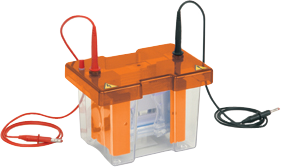Electrophoresis is the motion of dispersed particles relative to a fluid under the influence of a spatially uniform electric field. Electrophoresis of positively charged particles (cations) is called cataphoresis, while electrophoresis of negatively charged particles (anions) is called anaphoresis.
What is Gel electrophoresis?
Gel electrophoresis is a method used to separate molecules based on size and charge. It is commonly used in molecular biology to separate DNA, RNA, and proteins. The molecules are placed in a gel matrix and an electric current is applied, causing the molecules to move through the gel. Smaller molecules move more easily through the gel, so they migrate faster and farther than larger molecules. By comparing the distance migrated by a sample molecule to that of a reference molecule of known size, it is possible to determine the size of the sample molecule.
There are several different types of gel electrophoresis, including agarose gel electrophoresis and polyacrylamide gel electrophoresis. Agarose gel electrophoresis is commonly used for separating DNA molecules that are larger than 1 kb, while polyacrylamide gel electrophoresis is used for separating smaller molecules, such as oligonucleotides and peptides.
Gel electrophoresis is a useful tool for analyzing the size and purity of molecules, as well as for separating mixtures of molecules. It is an important technique in many areas of biology, including genetics, biochemistry, and molecular biology.
What is it used for?
Gel electrophoresis is used for a wide range of applications in molecular biology, genetics, and biochemistry. Some of the main uses of gel electrophoresis include:
- Analyzing the size and purity of molecules: Gel electrophoresis can be used to determine the size and purity of DNA, RNA, and protein samples.
- Separating mixtures of molecules: Gel electrophoresis can be used to separate mixtures of DNA, RNA, or protein molecules based on size and charge.
- Detecting and analyzing genetic variations: Gel electrophoresis is commonly used in DNA fingerprinting and other techniques that rely on identifying genetic variations, such as single nucleotide polymorphisms (SNPs).
- Cloning and sequencing DNA: Gel electrophoresis is used to purify DNA fragments that have been amplified by polymerase chain reaction (PCR) and to separate and purify DNA molecules for sequencing.
- Analyzing protein function and structure: Gel electrophoresis can be used to separate and identify different types of proteins, as well as to study the structure and function of proteins.
Overall, gel electrophoresis is a powerful and widely used technique that plays a key role in many areas of molecular biology, genetics, and biochemistry.


.png)
.png)
When you need to choose electrophoresis you should consider the following:
- Power Supply-you can choose with different watt
- Gel Electrophoresis Systems – you can choose in different sizes
- Gel Dryers - you can use before documenting the result
- Documentation system - includes a direct connection to the computer
- Extra: UV Transluminators - used to observe the gel in addition to recording it with the documentation system .